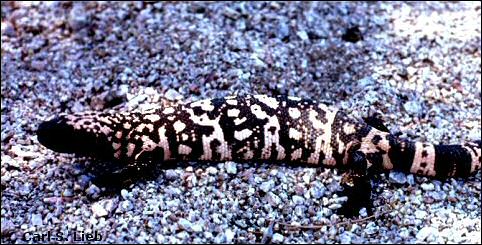
Almost everyone has heard of the Gila Monster and knows that it's a poisonous desert creature. Except for a small area in southwestern New Mexico and southeastern Arizona, it's not a Chihuahuan Desert lizard, occurring mostly in the Sonoran Desert. It's one of only two venomous lizards in the whole world, with the other a close relative living in Mexico.
Its looks also attract attention, both because of size—a stocky 15 inches or so—and color. Its beaded skin displays a pattern of black and orange or pinkish colors, possibly warning coloration. Despite its reputation, human deaths from Gila Monsters are relatively rare, usually occurring only in the very young or those whose health already is challenged. In this, it's very much like other Chihuahuan Desert poisonous animals, where the effects of the venom may be severe, but deaths rare.

Contributor: Arthur H. Harris, Laboratory for Environmental Biology, Centennial Museum, University of Texas at El Paso.
Desert Diary is a joint production of the Centennial Museum and KTEP National Public Radio at the University of Texas at El Paso.

Gila Monster (Heloderma suspectum). Photograph by Carl S. Lieb.
There is evidence that our desert supported its own Gila Monster in the past—that center of diversity, Big Bend, had its own version back in the Miocene, more than 20 million years ago.
Fossil Heloderma from Big Bend